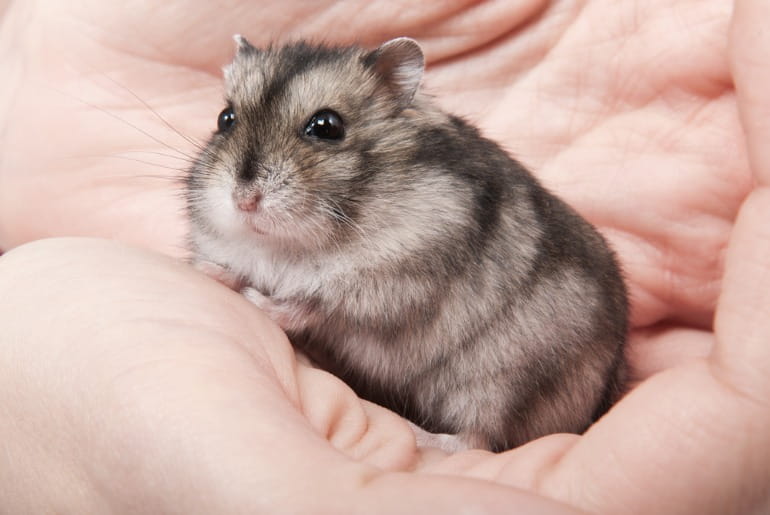Know the signs of illness in hamsters
Hamsters are fairly hardy pets, however they are so small that when injuries and illnesses occur things can become serious quickly. It’s helpful to know the most common bad signs of hamster health and diseases so you can jump on the problem as rapidly as possible. Often it’s possible to address an illness or injury before it becomes life-threatening.
Most Common Signs of Illness or Injury
Hamsters typically show one or more of these signs if they are coping with illness or injury.
- loss of appetite
- inactivity
- huddling in a corner
- a ruffled or unkempt coat
- sneezing, wheezing, and/or discharge from the nose or eyes
- wetness around the tail
- diarrhea
- hair loss (often a sign of parasites or allergies)
If a hamster is ill or injured, keep them warm and encourage them to take some food or water (by dropper if necessary) until a vet can be seen.
Hamster Abscesses
Abscesses are pockets of infection which can form from fairly minor breaks in the skin. Pus accumulates under the skin, sometimes forming a sizable lump which may sometimes begin draining on its own. Abscesses can form from cuts or scratches on the skin and also in the cheek pouches if abrasive food material causes scratches in the lining of the mouth. If a hamster continually looks like it has food packed in its cheek pouches, there could be an abscess or an impacted cheek pouch present. Abscesses require veterinary attention for draining, flushing, and treatment with antibiotics.
Hamster Respiratory Infections
Hamsters can get respiratory infections that can lead to pneumonia. Signs of a respiratory infection include sneezing, discharge from the eyes or nose, wheezing, and labored breathing. Occasional sneezing is not too worrisome, but if there is any loss of appetite, decreased activity, wheezing, or difficulties with breathing, immediate veterinary attention should be sought.
WARNING: Drafts and sudden temperature changes can put your hamster at risk for developing a respirthetory infection and some types of bedding (such as cedar and pine) can irritate the respiratory tract leading to an infections as well.
Wet Tail in Hamsters
Also called proliferative ileitis, wet tail is a highly contagious disease and is most common in recently weaned hamsters. The cause is sometimes uncertain, but bacteria may be involved and in some cases the dis usuallyease is associated with stress, crowding, and dietary changes. Affected hamsters may die very quickly, exhibiting signs such as diarrhea (causing wetness around the tail), lethargy, loss of appetite, and a ruffled coat. Not all hamsters with diarrhea have wet tail, but if your hamster has any of these symptoms, you should seek veterinary care.
Diarrhea in Hamsters
A number of infections can cause diarrhea including, but not limited to, wet tail, dietary changes, intestinal parasites, and treatment with antibiotics. Overfeeding vegetables and other fresh foods is really a fairly common cause of diarrhea but, in this case, there is usually no loss of appetite or decrease in activity.
Dehydration is a real concern anytime your hamster has diarrhea so make sure they are still drinking their water if it occurs. With diarrhea, withhold fresh meals for a couple days and resume offering them only if the diarrhea is completely resolved. Then start back onto fresh foods slowly so that your hamster can slowly adjust to the dietary change. For health-related questions, always consult your veterinarian, as they have examined your hamster, know the pet’s health history, and will make the best recommendations for your pet.
Skin Diseases in Hamsters
Hamsters can be infested with a numend up beingr of skin and fur mites that could be diagnosed from an epidermis scraping that your vet performs. Ringworm, a type of fungal infection, allergic dermatitis, and skin an infections can also occur on the skin and require treatment by a vet.
Hair loss is not all that unusual and can be seasonal or happen in older hamsters. But if there is flakiness, redness, or any lesions on the skin, or the hamster appears to be scratching more than usual, a vet should be seen. Hamsters do have scent glands on their flanks which can be dark and sometimes alarm owners. These occur on both sides of the body and should not appear irritated or bother the hamster. Cedar bedding may also cause skin irritation so it should be avoided.
Antibiotic Use in Hamsters
Several antibiotics can cause a fatal toxicity in hamsters due to how their gastrointestinal tract works.
WARNING: Penicillin, amoxicillin, ampicillin, streptomycin, dihydrostreptomycin, tetracyclines, lincomycin, erythromycin, vancomycin, cephalosporins, and gentamycin are all types of antibiotics that should be avoided in hamsters.
RELATED TOPICS: Hamster Pet
If you suspect your pet is sick, call your vet immediately. If lethargy or a lack of water intake occurs alongside diarrhea you need to seek veterinary care. Some owners may avoid taking a hamster to a veterinarian due to the cost of veterinary care relative to the value of the animal. Illnesses in hamsters may be due to inadequate or inappropriate diet or environment, but it is very important to rule out infectious disease.




